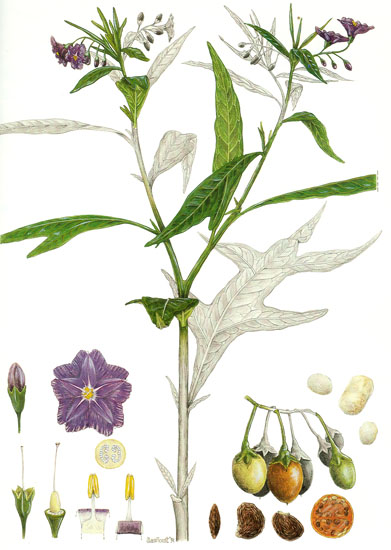
Synonymy
Solanum laciniatum Aiton, Hort. Kew. 1: 247 (1789)
S. aviculare var. laciniatum (Aiton) Domin, Biblioth. Bot. 89: 574, fig. 183 (1928); S. pinnatifolium Salisb., Prodr. 133 (1796); nom. illeg., based on S. laciniatum Aiton.
T: Native to New Zealand, J. Banks s.n.; lecto: Bot. Mag. 10: t. 349 (1796), fide G.T.S. Baylis, Trans. Roy. Soc. New Zealand 82: 642 (1954). The illustration which forms the lectotype has been reproduced here or it can be accessed from the online collections of the Te Papa Museum in Wellington, New Zealand.
Description
Shrub to 3 m, green, the stems often purplish, glabrous except for minute glandular hairs on young growing tips and buds, and simple hairs on seedlings and young leaves; prickles absent.
Lobed leaves broadly ovate; lamina 9-38 cm long, concolorous, deeply lobed; lobes 2-13 cm long, 0.3-2 cm wide; petiole 1-4 cm long. Entire leaves lanceolate; lamina 5-20 cm long, 1-4 cm wide, concolorous; petiole 5-10 mm long.
Inflorescence up to 10-flowered; peduncle to 4 cm long; rachis 5-15 cm long, often forked; pedicels 1.5-3 cm long. Calyx 4-6 mm long; lobes triangular, 2-3 mm long, slightly enlarged in fruit. Corolla rotate, 30-50 mm diam., deep purple-blue; lobes notched. Anthers 3-4 mm long. Fruiting axis 10-20 cm long.
Berry ellipsoid to ovoid, 15-20 mm diam., yellow to orange-yellow. Seeds 2-2.5 mm long, reddish-brown. Stone-cell granules usually 2-2.5 mm long. n=46.
Distribution and ecology
One of the Kangaroo Apples or subg. Archaeosolanum, S. laciniatum occurs mainly in south-eastern Australia, in southern N.S.W., Vic., Tas. and S.A., with localised populations in south-west W.A. Also native to N.Z. Associated with stabilised sand dunes, creek lines, and road verges in scrub and woodland.
Common name
Kangaroo Apple
Relationships
One of the Kangaroo Apples or subg. Archaeosolanum. Further information about this group of species can be found in Symon (1994).
S. laciniatum is often confused with S. aviculare G. Forster, but is distinguished by the rotate corolla with notched lobes, the yellowish fruit and larger seeds.
Notes
Cultivated in U.S.S.R., eastern Europe and N.Z. as source of solasodine for cortico-steroid drugs. Several cultivated forms are recognised.
Ripe fruit are eaten by Aborigines in Tasmania and by Maori in New Zealand - but be aware that unripe fruit are poisonous.
Selected specimens
W.A.: Perth, 22 Jan. 1969, R. Brown (PERTH). S.A.: c. 22 km N of Beachport, J. Carrick 2190 (AD). N.S.W.: Inverell, 29 June 1910, D.V. Johnson (NSW). Vic.: 55 km NW of Bairnsdale, M.G. Corrick 6166 (MEL). Tas.: Huon Rd, Tas., Sept. 1894, L. Rodway (HO).
From the web
Further information on this species in NSW can be seen on the PlantNET site and a fact sheet for this species can be downloaded from the SA eFlora site.
Depicted by John Lewin in his illustration between 1803 and 1808 - see image in the NSW Library athttp://image.sl.nsw.gov.au/cgi-bin/ebindshow.pl?doc=pxc304/a633;seq=198
A fact sheet with copious images of S. laciniatum can be found on the New Zealand Plant Conservation Network site.
Horticultural information can be found at www.anbg.gov.au/gnp/gnp12/solanum-laciniatum.html and on the Plants for a Future site. Its use in revegetation projects is treated in a downloadable sheet from the Corangamite Seed Supply & Revegetation Framework Project
Green fruits are considered to be poisonous but the ripe fruits are apparently edible - see http://www.sbs.auckland.ac.nz/uoa/science/about/departments/sbs/newzealandplants/maoriuses/food/trees-and-shrubs/poroporo-solanum.cfm
Further information, images and links for this species can be found on the Solanaceae Source site.
Relatively recently (2006) the species was found growing in the London area - see http://www.nhm.ac.uk/about-us/news/2006/july/news_9061.html




